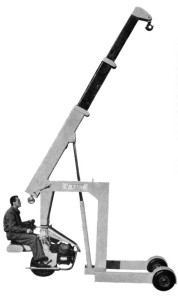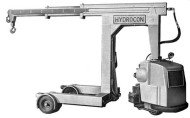 Warehouse & Logistics News is proud to bring you the fiftieth instalment in our exclusive series on the history of the fork lift truck, the machine that over the decades has revolutionised the face of materials handling around the world. Our series has now reached its half-century in terms of the episodes we’ve published so far, so we’re celebrating reaching a major milestone. And there’s still plenty of the story to come.
Warehouse & Logistics News is proud to bring you the fiftieth instalment in our exclusive series on the history of the fork lift truck, the machine that over the decades has revolutionised the face of materials handling around the world. Our series has now reached its half-century in terms of the episodes we’ve published so far, so we’re celebrating reaching a major milestone. And there’s still plenty of the story to come.
Our writer is James Brindley, an acknowledged authority on fork lift trucks. James’s distinguished career has involved engineering and management roles with BT Rolatruc and serving as a Director of the Fork Lift Truck Association, before he set up the National Fork Truck Heritage Centre in 2004 as Britain’s first such collection open to the public.
The Heritage Centre continues to need your support in 2010, and if you or your company would like to help in any way, you can contact James on the number below. Now sit back and enjoy the latest part of this fascinating series.
Episode 50: 1966 – Yale innovates with battery power
Besides forklift trucks with the odd lifting beam attachment, most factory applications at times experience the need for a small mobile crane to unload the more awkward loads from lorry to pallet. In early 1966 there were two such models designed for more frequent usage, both available in quantity.
The Valla had its origins in Italy and the Hydrocon Hornet was designed in Glasgow. Both machines were three-wheeled with two of the wheels at the end of a “U” shaped frame. The third wheel was used to drive and steer the machine. Both cranes had a similar design, from the performance tables and specifications down to the hydraulically extended jib. This was also the case even when a fork attachment was fitted. Where they differed was in the power units.
The ” Hornet” was equipped with hydraulic transmission and powered by a four-cylinder Ford 105E petrol engine whilst the “Valla”, better known in Italy as the V Kart, had a conventional gearbox and was powered by a single cylinder petrol driven 10 hp unit. If required the machines could be fitted with an LPG option. Both light cranes were made in Britain, the “Hornet” by the Lambert Engineering Company and the “V Kart” by Geoffrey Macpherson Ltd.
Prior to the May 1966 Mechanical Handling Exhibition at Earls Court the Yale Company announced three new battery controlled forklifts. Two were pedestrian operated. The first of these was a 3,000lb capacity powered pallet truck named “M3P,” which was an extension to the popular Worksaver range, and the second was a revamp of the Super Series Worksaver range of powered pallet equipment. Both trucks incorporated the new improved operating handle with hand guard and butterfly speed control.
Yale’s third new addition was to start a new trend in maritime operation, with a completely redesigned version of the KL 51 battery-powered counterbalance. Designated the “Tween Deck” rider trucks, the machines with a lifting capacity of 4,500 lb and 6,000 lb were chosen for the redesign. This reconstruction enabled them to be used between ships decks, where manoeuvrability and the ability to work in confined spaces were essential. The machines were also designed to dismantle into units weighing no more than 3 tons, so they could be lifted between decks with the ship’s own crane system. At this time the trucks had been chosen as standard equipment on board cargo passenger liners of the Ben Line, which operated between the UK, Northern Continental ports and the Far East. It was proposed that all future ships of this line were to be equipped with similar forklift trucks.
 In the mid-1960s British manufacturers were also showing a major interest in the use of forklift trucks on board ships. The main thrust of this was with the cooperation of the Royal Navy on board the large supply ships. Building on an order placed in 1965, the Ministry of Defence ordered a further four machines from Short Bros and Harland Ltd. These had lifting capacities of up to 12,000lbs to handle the large and bulky items of equipment such as the long-range aircraft fuel tanks on board HMS Eagle.
In the mid-1960s British manufacturers were also showing a major interest in the use of forklift trucks on board ships. The main thrust of this was with the cooperation of the Royal Navy on board the large supply ships. Building on an order placed in 1965, the Ministry of Defence ordered a further four machines from Short Bros and Harland Ltd. These had lifting capacities of up to 12,000lbs to handle the large and bulky items of equipment such as the long-range aircraft fuel tanks on board HMS Eagle.
Other companies showing more than a passing interest in the development of suitable equipment to meet the precise naval specifications were Lansing Bagnall and Cleco. In the case of Cleco, they had just completed a study on handling long loads down the narrow gangways through the centre of the ships. These were found to be too narrow for a conventional counterbalance. A side loading truck with modifications was subsequently trialled, and performed very successfully.
To be continued
By James Brindley, Director, National Fork Truck Heritage Centre.




Comments are closed.